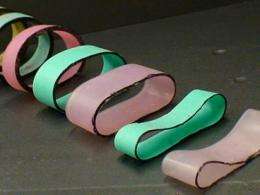Galileo revisited: How ribbons roll

Galileo Galilei’s experiments on the motions of falling and rolling objects, described in his 1638 book, “Two New Sciences,” are considered by many to be the beginning of modern science. Now researchers at MIT have conducted a variation on his experiments that has produced unexpected results.
Galileo used rigid materials — metal balls and a wooden ramp — for his tests on how bodies move down an inclined plane. Since then, a few tests have been done with solid balls rolling down a flexible surface. But until recently, nobody had tried rolling flexible objects down a solid plane. MIT professors Pedro Reis and John Bush, along with visiting student Pascal Raux and visiting professor Christophe Clanet, have now carried out experiments using a variety of flexible, hollow cylinders — essentially wide rubber bands — with different degrees of elasticity, and have derived a set of equations to describe the behavior of these "rolling ribbons." The work was described in a paper published in July in the journal Physical Review Letters.
Flexible ribbons initially settle into an oval shape because of gravity, and one might expect them to get rounder as they roll due to centrifugal force. But the opposite occurs. The faster the ribbons roll, the more they lose their circular shape, eventually assuming a two-lobed “peanut” shape. At even higher speeds, the sagging middle droops so far that it comes in contact with the bottom of the ribbon, causing friction that makes the loop suddenly lurch backward. The researchers say the behavior is the result of “a delicate coupling between rolling, bending and stretching.”
Though this was basic research, Reis speculates that the resulting analysis might ultimately be useful for applications as varied as predicting the motions of microscopic cylinders called carbon nanotubes, the behavior of drill casings in deep wells, and the way blood cells move through veins and arteries. (Red blood cells are known to have a similar characteristic peanut-like shape, but that shape has never been fully explained.) Bush, a professor of applied mathematics, explains that “one of our goals is to better understand the role of flexibility in locomotion.”
The research was prompted by a suggestion from Clanet, who taught a course at MIT during a stint as a visiting lecturer. He is a professor working at the Laboratory of Hydrodynamics at the Ecole Polytechnique in Palaiseau, outside Paris. Raux, a student visiting MIT from Paris, was the lead author of the paper.
Video courtesy of Pascal Raux and Pedro Reis. This video illustrates the shape transformation of a flexible polymer ribbon, otherwise circular, when rotated on a treadmill.
Why has it taken almost four centuries for scientists to take this next step from Galileo’s work? Reis explains that despite their apparent simplicity, the behavior of flexible structures is often nonlinear — that is, it requires more complicated mathematical equations to describe than that of simple rigid objects, and so the analysis wasn’t feasible before the advent of computers. And in addition, only relatively recently has it become easy to make objects out of flexible polymers with any desired degree of elasticity and shape using modern fabrication tools.
In this case, team members had to create the flexible cylinders from scratch — they employed a polymer that dentists use to make casts — because commercially available versions, such as wide rubber bands, do not have precise enough shapes with constant thickness.
Lakshminarayanan Mahedevan, a professor of applied mathematics at Harvard University, has published research on a different variation of Galileo’s experiments but was not involved in this work. Mahedevan says this basic research “has implications for how surfaces in contact move relative to each other.” But what really matters, he says, is the basic principles discovered in this way: “The particular manifestation is less important than the general principles that underlie these types of deformations.”
As with much basic research, the ultimate usefulness of the work is hard to predict, although there are clear examples of areas where such rolling behavior occurs. But for the researchers, there was a real thrill in finding a way to extend work that has such a fabled history. “One thing that made it really neat for us from the start was the connection with Galileo, to take an experiment that has been a classic” and extend it in a new direction, says Reis, the Esther and Harold E. Edgerton Assistant Professor of Civil and Environmental Engineering and Mechanical Engineering.
This story is republished courtesy of MIT News (web.mit.edu/newsoffice/), a popular site that covers news about MIT research, innovation and teaching.
Provided by Massachusetts Institute of Technology



















